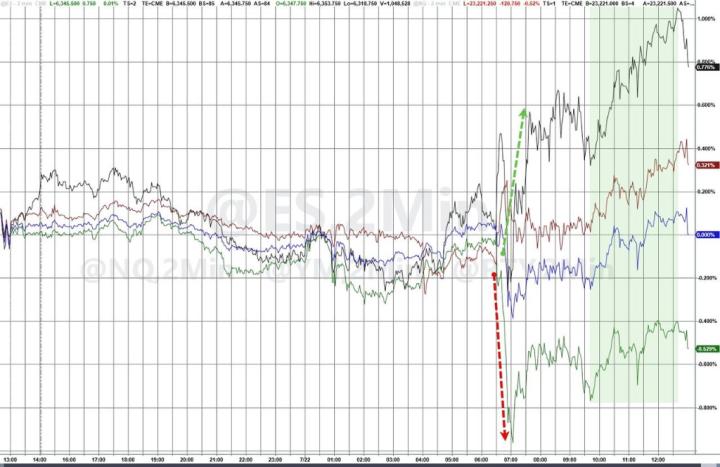Original Author: Ada, TechFlow
"The bull market is here, but why are all groups so quiet?" netizen Tongxin Milk Cheese raised doubts in the Opensky community group.
"Because of empty positions and short positions," group member Niner replied.
For Niner, who experienced the previous bull and bear market, this bull market should have been a good time to make a lot of money, but Niner frankly admitted that he "hasn't made money in this market".

Full-time trader Johhny is in a similar situation, claiming he "hasn't made money since Trump posted Trump".
Such cases are not uncommon. Wagmi Capital partner Mark stated in an interview that in this bull market, "90% of retail investors are not making money".
Although Niner hasn't made money yet, he has adjusted his investment strategy in time. "In the last cycle, I mainly 'held dead', but this time I mainly do swing trading, and because many new things have emerged, I need to continuously learn, and the pace is much faster."
Niner's adjustment was timely, but most people are still late to realize.
"The investment logic in this cycle is already different from before, but most retail investors haven't realized it yet," KOL River Horse said in an interview.
As institutional funds massively enter the crypto market and mainstream coins repeatedly hit new historical highs, this is no longer a "retail-friendly" market, whether in terms of funds, technical acceptance, or participation degree. Some believe that the crypto dividend period for retail investors is ending, and this might be the last cycle for retail investors.
Based on this, TechFlow interviewed multiple deep participants in the crypto market, including famous KOLs, private fund partners, quantitative traders, and individual investors, to analyze this bull market from their perspectives and present a diverse crypto landscape.
A Different Crypto Bull Market
River Horse, who entered the crypto market in 2016, is very familiar with the crypto market. During the interview, he spoke clearly and loudly, calmly describing his observations of this bull market: "This is no longer a universally rising market. If previous bull markets were consensus-driven, this bull market has taken a completely different path under the divergence of various policies, capital, and camps."
River Horse, a former military personnel who previously worked in commercial real estate before crypto investing, has a bold yet cautious investment style. After experiencing several bull and bear markets, he says, "I've been thinking about what is truly valuable in this industry, what assets can truly transcend bull and bear markets?"
If the previous market wasn't clear enough, this market has gradually helped River Horse find his answer.
"Actually, I've thought about this repeatedly, and now I realize this industry is a financial internet. Whether it's lending, trading, pledging, or the currently popular US stock tokenization and stablecoins, they are essentially centered around finance and require complete financial infrastructure and systems," River Horse said. "Based on this thinking, I believe Ethereum still has great potential, so I'm mainly deploying in Ethereum and DeFi assets."
In River Horse's view, this bull market started with BlackRock officially passing the Bitcoin ETF, had a short-term adjustment, and opened the second stage after the US passed the Beautiful Big Law, expected to peak in November.
However, Mark has a different perspective.
He indicates that the Memecoin surge in the second half of last year was the starting point of this market trend and the first half of the bull market. The second half originated from Ethereum's recent rise, driving a new wave of market momentum. He predicts the market will reach its peak in September.
"In 2017, it was an ICO bull market, then an Altcoin bull market, but this cycle is clearly different because the mystique has been dispelled, many concepts and stories have been proven false, leaving only financial applications. So even with Ethereum's big rise, it hasn't broken its historical high, and Altcoins only have partial gains," Mark said.
Quantitative trader Cheng Hua, another market veteran, now runs his own quantitative trading studio focusing on crypto arbitrage.
Cheng Hua noticed early in this market trend that it differed from previous cycles: previous cycles were driven by retail investor funds with small coins rising fiercely. This time, more mainstream funds have entered, flowing primarily to mainstream coins like Bitcoin.
However, he was still "washed out". Although he still holds Bitcoin, he sold most of it when Bitcoin just broke $100,000 and switched positions during Ethereum's steepest decline, missing its recovery. Even for industry veterans, precisely timing the market remains challenging for retail investors.
Where Are the Opportunities for Retail Investors?
For full-time trader Johhny, the most direct feeling in this bull market is: "Too many coins, no innovation in gameplay, insufficient liquidity, making it increasingly difficult for retail investors to make money."
Johhny entered the crypto market during the last bull market, riding the Dogecoin shill wave by Musk, and made a fortune in the universally rising market. "At that time, I didn't even know what a candlestick chart was, but still made money," Johhny recalled.
But those good days are gone.
"The previous investment strategy is no longer applicable to this cycle," Johhny said. "I used to like 'holding dead' or buying whatever others shilled. Now I need to learn to build a trading system that suits me."
Even so, "the upside potential of on-chain meme coins is not as large as before. Market capital and technical barriers are getting higher, and the money-making effect is getting worse," Johhny said.
So, why is it difficult for retail investors to make money in this bull market, and where are their opportunities?
Mark believes retail investors struggle to make money for two main reasons.
First, most retail investors haven't shifted from the previous bull market logic, still mainly holding Altcoins instead of mainstream coins.
Second, they frequently change positions. "Chasing highs and killing dips is a common trait of retail investors and the biggest enemy of making money," Mark said.
Mark believes the main opportunities in this bull market are in mainstream coins and Memecoins. With improving liquidity, he's discovered a new opportunity - "Recently, newly listed coins on Binance have several times the gains, no longer getting halved like before." He said, "So I made an adjustment: the majority of funds are still in Ethereum, but I'll use a small portion to chase new coins, betting small to win big."
"But actually, not many opportunities are left for retail investors," Mark is pessimistic. He believes the future crypto market will become more like the US stock market, with mainstream coins dominated by institutional funds, leaving only the Memecoin market for retail investors. However, to make money in the Memecoin market requires a good mind, time, and energy, which will filter out unqualified investors. Probably only 10% of people can make money in the Memecoin market.
River Horse agrees partially but also suggests paying attention to coins derived from trading.
Because trading-related projects are useful and unavoidable in the market, those that can survive are more likely to form consensus.
"For retail investors, the first thing to adjust might be their mindset, which is to give up the fantasy of getting rich quickly," Hippo said. "In the future, there might not be opportunities for Altcoins with dozens or hundreds of times returns, but there are still opportunities for mainstream cryptocurrencies, with about 3-5 times growth potential in each cycle. Then, focus on Memecoin, as new phenomenon-level Memecoins will emerge in each round, which will definitely bring significant returns."
In the previous cycle, there were some low-threshold, retail-friendly, low-risk money-making projects like IPO participation and inscriptions, but such opportunities are now scarce in this round.
"Or do quantitative trading like me, which has barriers but relatively low risk," Chenghua said. "I actually think the opportunity with Bitcoin is relatively fair for everyone, depending on whether one can grasp it. Dollar-cost averaging is a strategy that I think is relatively easy to execute, and if you extend the time horizon, you'll likely have decent returns."
Are Retail Investors' Crypto Dividends About to Disappear?
In fact, during the previous cycle, with the entry of some institutional funds, there were already voices saying it was the last crypto cycle for retail investors.
While retail investors are still participating in this bull market, this round is more "institutionalized".
The total AUM of Bitcoin spot ETF will reach $137.4 billion in July 2025, with over 400 institutions investing in BlackRock's Bitcoin ETF, including pension funds and sovereign wealth funds.
Global listed companies hold 944,000 BTCs, accounting for 4.8% of circulating supply, with a quarterly increase of about 131,000 BTCs.
Platforms like Coinbase and Binance have seen a surge in ETH liquidity staking (LSD) product scale, with institutions packaging ETH's income attributes as fixed-income instruments.
These data all indicate that the crypto market is no longer a playground for retail investors.
Some media reported that the $120,000 Bitcoin was just a "capital feast without retail investors". On that day, there were no "overnight wealth" screenshots, only BlackRock's silent scrolling of 13 ETF subscription orders per second.
This scenario completely meets Mark's expectations. "I feel the golden age of retail investors making money is over, and it was quite obvious that last year's second half might have been the last window period," he said.
He has already realized profits on part of his funds and shifted to A-shares.
"But I won't completely exit. I think the MEME market opportunities will always be there, and new things will emerge," Mark plans.
Relatively speaking, Niner is more optimistic. She says she will continue to immerse herself in this market because she feels "the chances of making big money are increasingly coming to retail investors."
"Many have been saying it's the last cycle for a long time. But I think the wild growth period is over, and now is the time for good opportunities to emerge," Niner said. "I won't leave. I want to be a true Alpha player."
Hippo is also optimistic. He believes the market is developing in an orderly and regulated direction, which for retail investors means low risk and high returns.
"With institutional funds entering, as long as you follow mainstream cryptocurrencies, you can still obtain relatively good returns. Most importantly, this market is controllable, and risks have been significantly reduced," Hippo said. "At the cycle's low point, Bitcoin might retract 50%-70%, but it will rise several times in a bull market. Just by capturing this rhythm and managing expectations, investing in Bitcoin and other mainstream cryptocurrencies might be the easiest money-making project for retail investors."
For Hippo, who has been deeply involved in the crypto field for 9 years, his relationship with this market is like "fish and water" - "I'm already swimming freely in this market and have never thought of leaving. Moreover, I believe market opportunities for retail investors have always been present."
Perhaps, whether optimistic or pessimistic, once immersed in this market, it's hard to easily say goodbye. What truly matters is not whether the market offers opportunities, but having the learning ability to keep up with the market, the eyes to discover opportunities, and the execution to seize them.








